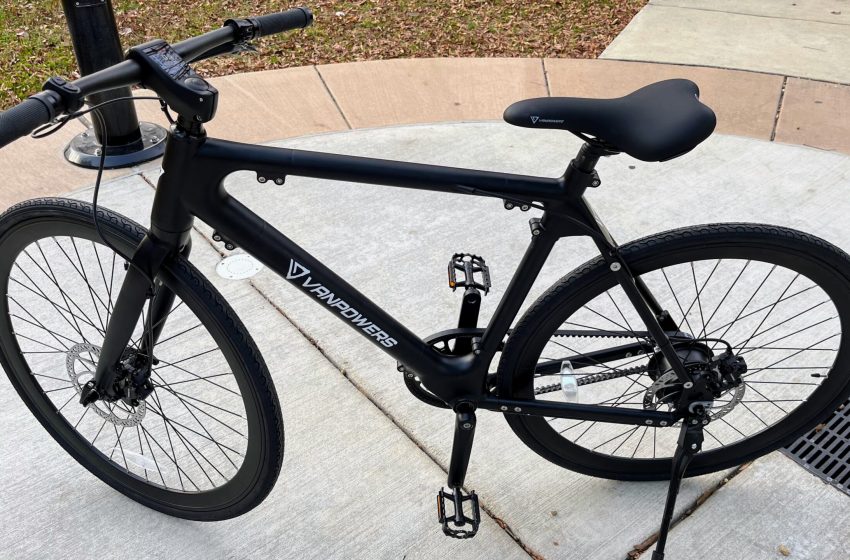Vanpowers City Vanture e-bike review: Sleek, streamlined, and hard to define

Looks acoustic, needs electric — Vanpowers City Vanture e-bike review: Sleek, streamlined, and hard to define There aren’t many e-bikes like itpartly because you can build it yourself.
Kevin Purdy – Feb 5, 2023 12:00 pm UTC Enlarge / The Vanpowers City Vanture. Spotting the “e” on this e-bike at a glance is trickier than most.Kevin Purdy reader comments 63 with 0 posters participating Share this story Share on Facebook Share on Twitter Share on Reddit
A “city” bike could mean many different things. It could be cheap, so there’s less angst when it is almost inevitably stolen. It might be simple, with fewer gears and add-ons because the commutes are short and relatively flat. Or perhaps it’s a lighter bike, one more easily hauled onto a curb or up a flight of apartment or office stairs.
Vanpowers’ City Vanture is cheap and light only compared to other e-bikes (fully assembled, it costs $1,750), but its belt drive, internal hub, and five-level assist make it somewhat simple. It’s also limited by a lack of accessory mounts and a gearing and motor setup that makes it more difficult to start and stop often in traffic or climb steep hills. For the right kind of rider, it could be a good pick. But you’ll want to look closely at the City Vanture before choosing it for your urban or trail commute.
Oh, and you can build it yourself if you want to save a few bucks. This bike is a collection of interlocking tubes held together by mortise-and-tenon construction and bolt collars. You put the tubes together, run the cables through them, bolt everything else on, and put the wheels in place. More on that in a bit. The City Vanture doing its version of off-road: a few feet off the Mount Vernon Trail on Gravelly Point in Washington, DC. Kevin Purdy The handlebar display on the City Vanture, showing battery level, speed, mileage (trip and total), and power level (with a tiny bit of LCARS style). Kevin Purdy The higher/lower controls on the left handlebar for adjusting motor assist. Kevin Purdy The City Vanture’s chainring, just with a belt instead of a chain. Kevin Purdy The rear hub of the City Vanture. If you buy the DIY version, you’re lining all this up yourself. Kevin Purdy Pedal on the City Vanture. Kevin Purdy Handlebar detail on the City Vanture. Kevin Purdy The bike
The City Vanture comes in one size, a 21-inch (53 cm) step-over frame that weighs 34 pounds. The “ideal rider height” is between 5 feet, 8 inches and 6 feet, 3 inches. Ars Science Editor John Timmer is 6-foot-2 and found the Vanture undersized for his long-legged build. “My knees feel like they’re up to my ears,” Timmer said after a casual 15-minute ride. I’m 6-foot-2 as well and felt the ride in my shoulders and core muscles more than on bikes better fit to my height. Your body-proportion experience will vary, but I’d be cautious if you’re tall. (You can get more specs on the Geometry section of the product page). A Vanpowers representative said the company is working to offer more model sizes in the future. Advertisement
You get just two major options when buying the City Vanture: color and whether you want to assemble the bike yourself to save $90 or have it shipped mostly pre-assembled. I went the DIY route. Your color choices are the relatively staid “Infinite Silver” and “Shining Black,” the two-toned “Chalk Blue” and “Ruby,” and the spot-it-a-mile-away purple/pink/aqua/seaweed “Neon Purple.”
Your only other option is adding accessoriesa custom rear rack, a frame bag, an anti-theft horn, and an additional range-extending water bottle-style battery. If you were considering a rear rack for this bike, you should buy it from Vanpowers. Because of how the bike is assembled and its lack of traditional mounting points for accessories (it doesn’t even have bottle cage bolts), I’m not confident that third-party racks would match the bolt size and placement of the City Vanture. There’s also very little clearance above either tire, and Vanpowers doesn’t offer its own fenders. Lights are whatever you can strap on.
The bike that arrives (or is eventually built) has a motor rated at 36 volts and 350 watts and a 252-watt-hour non-removable battery made from LG cells. Both are controlled by three buttons near the left handle and a waterproof display mounted between the headtube and handlebars. Vanpowers lists the top assist speed as 25 miles per hour and the standard range as 50 miles (80 kilometers), or 80 miles/130 kilometers with the bottle battery. Those numbers seem accurate; I clocked 44 miles before the display showed one or two bars left out of five, alternating between low and heavy power assist.
The motor runs on a cadence sensor, activating when your pedal cranks start turning rather than generating force. That choice, paired with the gearing of the combination hub/motor, is my major complaint about this bike. More on that in a bit. Enlarge Page: 1 2 3 Next → reader comments 63 with 0 posters participating Share this story Share on Facebook Share on Twitter Share on Reddit Kevin Purdy Kevin is a tech reporter and product specialist at Ars Technica, with more than 15 years’ experience writing about technology. Advertisement Channel Ars Technica ← Previous story Next story → Related Stories Today on Ars









